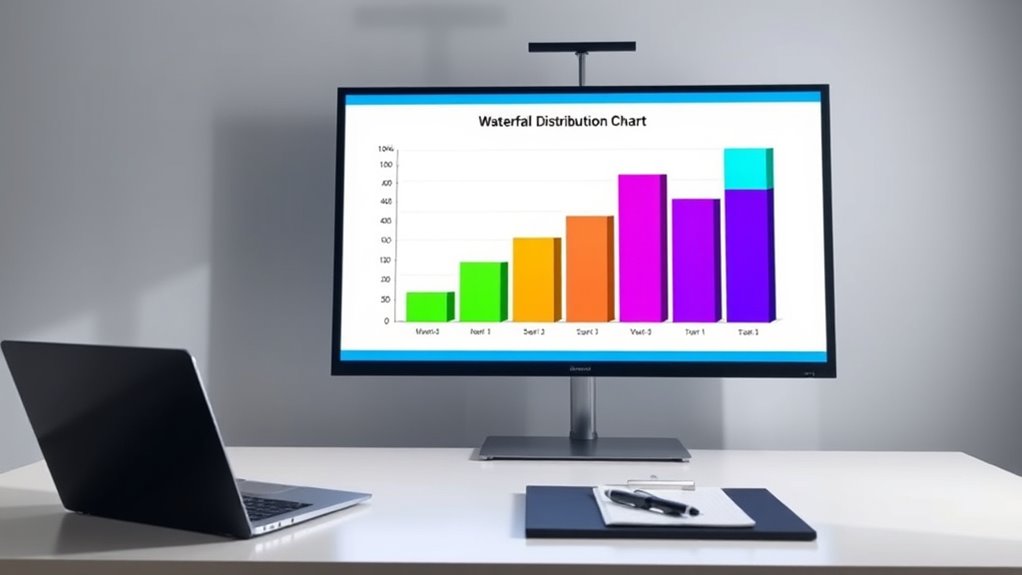To present waterfall distributions clearly in your PPM, use visual tools like charts and diagrams with distinct colors and labels to show how funds flow through each stage. Highlight key segments such as investments, costs, and profits, and include annotations for risk areas or contingencies. Guide your audience from an overview to detailed segments, ensuring transparency and understanding. Keep explanations simple, and if you continue, you’ll discover tips for making your presentation even more effective.
Key Takeaways
- Use distinct colors and clear labels to differentiate segments like capital, costs, and profits.
- Start with a high-level overview before diving into detailed distribution stages.
- Incorporate annotations or callouts highlighting risk areas and mitigation strategies.
- Maintain consistent visual elements to enhance quick interpretation and reduce confusion.
- Summarize key insights at the end to reinforce understanding and facilitate strategic discussions.

A waterfall distribution is a powerful tool in project portfolio management (PPM) that visually breaks down how value or costs are allocated across different segments. When presenting these distributions, clear communication is essential to guarantee stakeholders understand the flow of funds, risks, and benefits. To do this effectively, you should start by providing a straightforward explanation of what the waterfall chart represents. Outline how the initial investment, subsequent returns, and allocations across various project phases or departments are structured. This sets a solid foundation for your audience, making complex financial flows easier to grasp.
A waterfall distribution visually explains how value or costs are allocated in project portfolio management.
Next, emphasize the importance of a well-organized visual layout. Use distinct colors, labels, and clear demarcations to differentiate between segments such as initial capital, operational costs, and profit sharing. Consistent use of color coding simplifies interpretation, allowing stakeholders to quickly see which parts of the portfolio are generating value and which are absorbing costs. When highlighting the cash flow analysis, make sure to pinpoint how cash moves through each stage, from inflows to outflows, and how this impacts overall project viability. Visual clarity helps prevent misunderstandings and allows for more informed decision-making.
Risk mitigation is another critical aspect to address when presenting waterfall distributions. Incorporate annotations or callouts that identify areas of potential risk, such as segments with high exposure or uncertain returns. By doing so, you help your audience see where contingencies are in place or where additional safeguards might be necessary. Demonstrating how risks are distributed across the waterfall chart reassures stakeholders that risks are being managed proactively, which builds confidence in the portfolio’s resilience.
When presenting, start with a high-level overview before diving into detailed segments. This approach guides your audience through the big picture first, then progressively reveals specifics. Use real-world examples or hypothetical scenarios to illustrate how the waterfall operates in different situations. This contextualization anchors abstract concepts in tangible outcomes, making the distribution more relatable.
Finally, make certain your presentation includes a summary that encapsulates key takeaways, such as the overall cash flow health and risk mitigation strategies. Wrap up by inviting questions to clarify any uncertainties. Clear, concise communication paired with visually compelling data ensures your waterfall distributions are understood and appreciated by all stakeholders. In doing so, you foster transparency, facilitate strategic discussions, and support sound decision-making within your project portfolio management efforts.
Frequently Asked Questions
How Do I Choose the Right Waterfall Structure for My Project?
When choosing the right waterfall structure, you should consider your project’s valuation and how the capital stack is arranged. Think about the risk levels for different investors and the expected return hierarchy. Tailor the distribution tiers to align with your financial goals, ensuring clarity for all stakeholders. A well-structured waterfall balances investor incentives with project success, making it easier to present transparently in your PPM.
What Are Common Mistakes to Avoid When Presenting Distributions?
You might worry about confusing your investors, but avoiding common mistakes helps. To do that, steer clear of misleading graphics that distort the distribution’s flow and guarantee consistent terminology throughout your presentation. This prevents misunderstandings and maintains credibility. Remember, clarity is key—use straightforward visuals and clear labels. By doing so, you make your waterfall distribution easy to follow, building trust and making your PPM more effective.
How Can I Simplify Complex Waterfall Tiers for Investors?
To simplify complex waterfall tiers for investors, focus on clear visual representation. Break down each tier with straightforward labels and use diagrams or charts that highlight key thresholds and returns. Limit the number of tiers, grouping similar ones when possible, so investors can easily grasp the distribution structure. Keep the presentation concise, emphasize critical points, and avoid jargon, making it easier for your audience to understand the waterfall process at a glance.
What Software Tools Are Best for Creating Waterfall Diagrams?
When choosing software for creating waterfall diagrams, you want tools that excel in cash flow and distribution modeling. Excel is a great starting point because it offers flexibility and powerful formulas. For more advanced visualization, you might consider specialized financial software like Microsoft Power BI, Tableau, or dedicated modeling tools like Argus or Solver. These help you clearly demonstrate distribution tiers and make complex waterfalls easier for investors to understand.
How Do I Explain Waterfall Distributions to Non-Technical Stakeholders?
Waterfall distributions can seem complex, but you can make them understandable using visual analogies and simplified language. Think of it like a relay race, where each runner (stakeholder) gets a turn based on the order and share of the prize (funds). Explain that each tier shows how money flows, highlighting the sequence and amounts. This approach helps non-technical stakeholders grasp the concept without overwhelming them with jargon.
Conclusion
Now that you know how to clearly present waterfall distributions in your PPM, you’ll make your deal structure much easier for investors to understand. Remember, clarity builds trust and confidence. Are you ready to communicate your distribution plan effectively and stand out in the market? Keep it simple, transparent, and precise, and you’ll ensure your investors see the value in your project from the start. Clear presentation truly makes all the difference.









